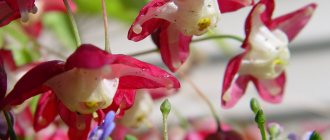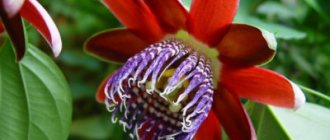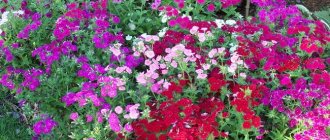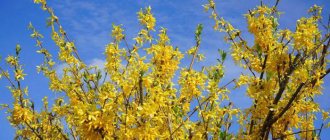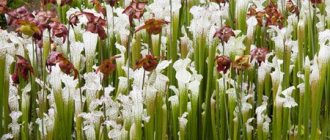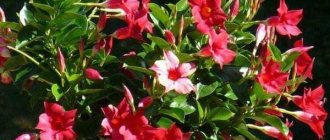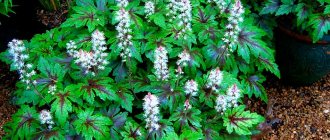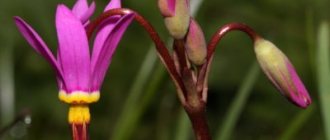Botanical description and homeland of the plant
In autumn the garden is transformed.
The green outfit of bushes and trees gives way to yellow, red, and crimson. There are very few flowering crops left. This is what Karyopteris is. The shrub has erect stems 1-1.5 m high, which begin to become woody at the base as they grow. In shape, it forms a hemisphere, the top of which is crowned with paniculate inflorescences. When closed, the corollas resemble clusters of berries. The flowers are small, soft pink, white, blue, blue-gray or purple. The leaves are oval-shaped with a carved edge, green-smoky in color (the variegated form has a yellow border), they exude a herbaceous-coniferous aroma. The appearance prompted the assignment of popular names to karyopteris: nutwing, blue fog, blue beard.
Wild nutwing thickets are found in Mongolia, Northern China and Central America. The shrub grows mainly on rocks and mountain slopes.
Types and varieties
The most popular among flower growers are Karyopteris clandonensis and gray-haired.
We recommend reading: Sand and crushed stone - salvation from the spring thaw
Klandonsky or Kladonsky is obtained by combining gray and Mongolian. It is also called variegated. The leaves are oval-shaped, with villi, often two-colored: yellow-green, greenish-brown. The bush is very dense, about a meter high, and has violet-blue inflorescences. It blooms from mid-summer to late autumn and is a frost-resistant crop.
"Summer sorbet" grows up to 80 cm. It has oblong-rounded leaves of a soft green hue, jagged edges, sometimes yellow in color. The flowers are bright blue, they are pleasing to the eye until the first frost.
Grey-haired - so named for the color of the leaves, they are grayish in color. The stems are covered with fluff and have a light citrus aroma. Height is about 1.5 meters. Small inflorescences smell like pine needles.
Tangut has a height of 0.5 meters to 2 meters. Oval-shaped leaves are located on gray stems with fluff. The flowers form a spike-shaped inflorescence of a blue-violet hue.
Mongolian is a semi-shrub plant up to 1.5 meters high. The shoots are straight, red-brown in color, with fibers. Inflorescences are blue-violet. Rarely found in natural conditions. This perennial blooms in its first year.
Forresta has pale blue or whitish-green inflorescences. Its leaves are elongated, rounded, gray-green in color, covered with fluff. It is an excellent honey plant.
Growing Karyopteris from seeds
Karyopteris seeds photo
Karyopteris seeds are sown in open ground before winter or early spring, if your climate conditions are not too harsh. The area is dug up, piles of earth are broken up, seeds are distributed over the surface and covered with a rake.
Growing seedlings is not particularly difficult:
- In early March, the seeds are sown in a wide container with a loose substrate (beginners most often use universal soil for growing seedlings, experienced gardeners prepare soil mixtures on their own: for example, sand and peat, peat with vermiculite, turf soil and sand).
- Simply spread the seeds over the surface without digging (you can lightly dust it with sand), spray with warm water from a fine spray bottle and cover with a piece of glass or transparent film.
- Place the containers on the western or eastern windowsill - diffused lighting is required.
- Maintain the temperature in the range of 22-25 °C.
- Raise the cover for ventilation every day for 20-30 minutes, and grow the seedlings without it, watering it moderately.
- Seeds germinate within 10-14 days.
- When a pair of true leaves appear, the seedlings are planted in separate small containers - peat or plastic cups.
- Transplantation into open ground is carried out after the establishment of real warmth (approximately in May).
If you miss the moment of cracking of the seed pods-nuts, the karyopteris will self-sow. It is important not to miss the moment to collect seeds if necessary or control the process of random sowing.
Growing karyopteris or an unpretentious shrub with character
To plant nutwing (another name), choose a well-lit area or with light partial shade.
In the shade, the shrub develops slowly, losing the bluish color of the leaves. In addition, the front garden must be protected from wind and drafts. Next, you need to understand the features of planting and caring for karyopteris. The choice of soil plays a key role in this matter. The soil under the bush plant should:
- have a loose structure;
- be well drained, so sand is added to the planting hole;
- differ in slightly acidic or neutral reaction.
To neutralize the acidity of the soil, a sufficient amount of limestone is added to the bed. At the same time, the crop does not take root in sandy soils at all. If you plant a seedling in clayey, waterlogged or heavy soil, then very soon its root system will rot, and the bush itself will quickly disappear. Moreover, overwintering karyopteris in such conditions is disastrous, because the remaining water freezes its root.
The first signs of plant wilting or disease are yellowed and curled foliage. Also, these symptoms indicate that the seedling has not taken root in the new location.
Planting karyopteris seedlings
By adhering to the basic rules of planting a crop, the gardener will be able to avoid many problems with growing nutcracker. It is recommended to carry it out in the last days of April, when it is dry and warm outside. To do this, buy a healthy Karyopteris cladonian seedling or its seeds.
On the site, shrubs are placed in groups, 2-3 specimens in each hole. A distance of 50-60 cm is maintained between them. For dense planting, they are planted in increments of 15-20 cm.
Having marked the site, the gardener begins gardening work:
- digs a hole that is 1.5 times deeper and 3 times wider than the root system of the seedling;
- forms drainage from humus or sand at the bottom (up to 10 cm);
- places the young plant in the center of the hole;
- gently straightens the roots;
- fills them with soil mixture;
- waters abundantly.
It is recommended to plant seedlings in the spring. If a specimen is purchased in the fall, then it is placed in a temporary pot with soil mixture and sent to a cool room for storage.
When buying crop seedlings, it is important to choose non-flowering specimens. Such specimens are resistant to anomalous phenomena, so they quickly take root in a new place. In addition, the presence of yellowed leaves on the bush indicates that the plant is sick and does not need to be planted.
Planting karyopteris by seed is a labor-intensive process
Some people will want to sow karyopteris seeds in open ground. The best time for this will be late autumn.
Growing nutcracker by seedling method is carried out in early spring:
- seeds are sown in pots, simply scattering them on the surface of the ground;
- spray the planting with a spray bottle;
- covered with film, which is removed every day for ventilation and watering;
- when sprouts appear, the “mini-greenhouse” is removed;
- Picking is carried out when the plant has formed 3-4 full leaves.
The seedlings are transferred to the flowerbed in the first half of May. At the same time, they adhere to the planting rules as for seedlings. Water the area only in dry weather, adding a moderate amount of liquid.
Reproduction of karyopteris by cuttings and layering
- Cuttings 10-15 cm long are cut in spring.
- For rooting, plant several pieces in a box or in pots one at a time.
- Cover the container with transparent film, bag or glass.
- It is convenient to use a glass jar or a cut plastic bottle to cover individual containers.
- Take loose and nutritious soil.
- Don’t forget to ventilate and water as needed.
- When the roots appear, the plant will begin to grow, produce new leaves and can be replanted in open ground.
Nutwings are also propagated by layering. In the spring, the partially lignified stem is pressed to the soil surface, secured with a clamp, and a mound of earth is poured at the point of contact, the top should stick out. Water periodically. The young plant should be dug up and replanted next spring.
Growing
To grow this flower, you need to purchase seeds or seedlings. The main thing when choosing a seedling is a visual inspection for damage. A good seedling has bright green leaves and a strong trunk; yellow foliage indicates a disease of the plant.
It is not recommended to purchase flowering crops; they take root less well. It is better to plant in the second half of April; if the seedling is purchased in the fall, you can plant it in a pot and store it in the cellar until spring.
It is better to plant in groups. You need to dig a hole that is slightly larger than the earthen root ball, and its width should be three times larger. It is necessary to place drainage in the hole; it can be sand and humus. Then insert the seedling into the hole, straighten the roots well, cover with soil and water.
It is important to know: karyopteris does not require frequent watering; it is a drought-resistant shrub.
It is better to plant seeds in the soil in late autumn or early spring. It is recommended to plant them in pots; they are scattered on top of the soil, without sprinkling. Then they cover it with film, creating a greenhouse. Periodically remove the film for ventilation and irrigation. After 2 weeks, seedlings appear; after 3 leaves appear, they are picked. At the beginning of May, seedlings can be planted in open soil.
Choosing a suitable location and landing features
Illumination of the area
Even with ideal care, the plant develops poorly if it is planted in an unfavorable place. The bluebeard shrub must be grown in an open sunny area, protected from drafts. The shadow negatively affects the appearance: the leaves (especially variegated forms) and flowers are much paler.
Soil requirements
The soil is suitable well drained with a small admixture of sand. Nutwing normally tolerates the presence of lime in the soil, but the acidic reaction of the soil and stagnant moisture are detrimental to it.
In order for a karyopteris seedling to turn into a beautiful bush with sky-blue flowers, it must be planted correctly. The agricultural technology is simple, but following it will ensure rapid successful establishment.
When to plant
Stick to planting deadlines. Karyopteris seeds can be sown in open ground in the spring and even before winter. It is best to plant your own seedlings or seedlings purchased from a nursery in the spring from mid-April. If you purchased a seedling in the fall, it is advisable to send it for winter storage in a basement or cellar.
How to plant
- Make the size of the planting hole 5-10 cm deeper than the height of the seedling’s earthen ball and 2-3 times wider than it.
- After planting, the root collar should be level with the soil surface.
- We place a nutrient cushion of humus at the bottom, add coarse sand as drainage and place a seedling in the center.
- We fill the walls with earth taken from the hole, mixed with sand.
- We water, let the water soak in and add more soil if the seedling is bare.
Choosing a place to plant karyopteris
Although karyopteris is a shrub, in cold winters it is more like a herbaceous plant, since the green parts of its shoots die off in severe frost, and only the semi-lignified lower parts remain until spring.
A drop in temperature below -15 °C is dangerous for the shrub, so it is recommended to grow it in countries with relatively mild winters or to protect it well before the onset of cold weather.
The plant can also grow in a pot, which at the end of autumn is brought into a cool room, where it is kept until spring, watered with a small amount of water.
"Summer sorbet"
Since seedlings in nurseries are sold with a closed root system, planting of karyopteris can be carried out from mid-May to the end of September, but gardeners recommend planting the bush in spring or early summer.
For growing, choose a sunny and warm place, protected from the cold winter wind. A good solution is to plant in close proximity to a stone fence or wall, which at night reflects the heat accumulated during the day.
Spring planting of trees and shrubs
The plant will grow in partial shade, but flowering will not be as abundant and long-lasting.
The shrub thrives in light, well-drained, limestone soil of average fertility with an alkaline reaction (pH 7.2-7.5).
However, the plant is not demanding in this regard and adapts well to medium sandy-loamy substrates with a neutral reaction. It grows poorly and gets sick on acidic, heavy clay and wet soils.
The planting hole should be twice the size of the root ball. A drainage layer of broken crushed stone or expanded clay is laid at the bottom; poor soil is mixed with several handfuls of compost and wood ash.
"Worchester Gold"
After planting, the earth is compacted, the bush is well watered, and the shoots are pruned, leaving only a few buds above ground level. The procedure stimulates the formation of numerous new shoots and subsequent abundant flowering.
Caring for Karyopteris
Karyopteris flower planting and care photo
Hardy, drought-resistant nutcracker does not require scrupulous treatment. It needs to be watered, fed, and pruned occasionally. It is important to organize the wintering of the plant.
Watering
Waterlogging the soil has a much worse effect on the condition of the bush. It is quite content with atmospheric moisture and should be watered during periods of severe drought. Between procedures, the soil should dry out well.
Feeding
When grown in fertile soil, it is not necessary to feed Karyopteris. In the spring, to stimulate growth, you can give a share of nitrogen by adding a solution of chicken manure infusion or azofoska. During the growing season, they are fed with complex mineral fertilizers a couple of times; on the eve of flowering, potassium and phosphorus are needed.
Trimming
Inflorescences produce only shoots of the current year, so the main pruning is carried out in the spring. At the level of 12 cm, cut off all branches. Weak and frozen shoots can be cut almost to the ground. In autumn, faded panicles are simply removed. If after a few years the bush begins to bloom worse, the shoots are practically without leaves, it needs to be rejuvenated: the branches are cut off, leaving a height of about 5 cm, the bush is divided, and the sections are replanted.
Care and reproduction
Caring for this flower is quite simple. It needs the following procedures:
- feeding;
- irrigation;
- pruning;
- shelter for the winter.
During the dry season, the shrub needs to be watered as the soil dries out. So it will bloom very magnificently and beautifully.
If the soil has a poor composition, then you need to choose good fertilizers . This is especially important during the growing season. In this case, you can use nitrogen mixtures. In summer, you can fertilize the soil with organic matter, potassium and phosphorus fertilizers, but no more than once every month.
You can prune the crop both in spring and autumn. In the autumn months, it is imperative to cut off dead inflorescences, and in the spring, damaged and weak shoots should be removed. It is advisable to give the plant a rounded shape. It is permissible to cut the stems almost to the ground.
Before winter, the crop is covered and wrapped in paper or burlap, and then sprinkled with straw or sawdust. If very significant frosts are expected, it is recommended to transplant the flower into a separate pot and place it in a room without heating. It is noteworthy that karyopteris can bloom even at temperatures as low as -3 degrees Celsius.
Blue mist propagates by layering or cuttings. For the last method, you need to cut off a part of the plant with buds about 13 cm long. After this, you need to ensure that the seedling produces roots.
For rooting, you can place the plant in a container of water or plant it in a pot with a nutritious peat mixture. To obtain layering, you need to select a completely healthy and strong stem. It is pressed to the ground with a special bracket, after which it is sprinkled with soil mixture.
Wintering of Karyopteris
Karyopteris flowers are killed by frost of -3 °C. The winter hardiness zone of karyopteris is 5-6 , which means that without shelter the roots will withstand short-term frosts down to -23 - -28 ° C. But with good shelter the shrub will overwinter well in open ground. The tree trunk circle is mulched with sawdust or straw, the stems are wrapped in burlap or thick paper (fixed with tape), and a heap of dry leaves is poured on top.
If a snowless winter is expected, or severe frosts in your region, it is better to dig up the shrub in the fall and replant it in a container. Store in a room with a temperature no higher than 10 °C and periodically water with small portions of water.
Useful tips
Due to the compactness of the plant, it can be grown not only in open ground, but also in pots on a balcony or loggia. Don’t forget about lighting the area where the shrub grows, because if there is not enough light, it will quickly fade.
The shrub loses its attractiveness if planted in unsuitable soil, such as acidic soil. To prevent it from aging, it is necessary to cut the shoots to 5 cm at least once every 4 years.
When flowering is completed, a fruit is formed - a nut, it is divided into 4 parts, very often they germinate. In order to transplant them, you just need to wait until they get stronger.
Take note: if you cut flowering shoots and place them in a vase with water, they will delight you with their freshness and aroma for a long time.
Karyopteris is a beautiful shrub that goes well with many grains, herbs, and flowers. Its blue color and rounded shape are eye-catching. Each type has its own advantages and characteristics, do not forget to take them into account when creating compositions in your garden. To fully enjoy the delicate aroma of the flower, you can plant it next to your house or gazebo.
How a decorative flower looks and grows, see the following video:
Diseases and pests of karyopteris
Carypteris has excellent immunity and there are practically no problems with diseases and pests.
Overmoistening of the soil can destroy the plant: the roots will rot, the stems will begin to die. The bush is urgently dug up, the affected areas are cut off and the remaining part is treated with a fungicide. The plant is transplanted into a fresh planting hole with drainage. To destroy pathogenic microflora, the previous area is also disinfected with a fungicide.
Occasionally, bushes are affected by horse flies (grass bugs). Dark dots, holes in the form of circles and dotted lines appear on the leaves. The bushes should be treated with an insecticide. Since the pest larvae are in the soil, in the fall the tree trunk circle is dug up so that they end up on the surface and die.
Planting and growing
The karyopteris shrub loves sunlight . If you plant it in a shaded place, it will develop very slowly, and its leaves will become very pale.
Wind and drafts also negatively affect the condition of the plant. The culture thrives in well-drained soil with the addition of a small amount of sand. The soil for it can be neutral or calcareous. Acidic soil is absolutely not suitable for karyopteris. Excessive moisture can also cause the death of a bush.
To grow a flower, you can use seedlings or seed material. When selecting seedlings, they must be inspected for defects and damage. Healthy planting material has a powerful trunk and green foliage. Yellowed leaves are a consequence of the disease.
You should not take flowering plants, as they may not take root. Planting is recommended at the end of April. If the seedling is purchased in the fall, then it can be planted in a separate pot and placed in the cellar for storage until spring.
It is better to plant shrubs in small clusters. For this purpose it is necessary to dig a spacious hole. It needs to have good drainage from humus and sand. After this, the seedling is placed in a hole, its roots are straightened and sprinkled with soil. Then the karyopteris needs to be watered abundantly.
It should be remembered that this ornamental crop does not need regular watering , as it is a drought-resistant shrub. The plant can be planted in the ground in late autumn or early spring. In this case, the young plant must be protected with polyethylene, sometimes removing it for irrigation and ventilation. After 2-2.5 weeks you can see the first shoots. You can start picking after 3-4 leaves appear.
Karyopteris in landscape design
Karyopteris in the garden photo
The time for Karyopteris to become decorative is at the end of summer and autumn, when most of the plants have already bloomed. It is valuable for its unpretentiousness, beauty and delicate aroma. Plant several bushes under windows or near a seating area. Nutwing is suitable for rocky areas, rockeries, alpine slides, and will enliven a mixborder or any flower bed. Combine with long-blooming annuals such as petunias.
Karyopteris with other flowers in the garden photo
A composition with yellow or burgundy flowers looks beautiful - marigolds, gatsania, rudbeckia, bidens, echinacea, annual dahlias.
Karyopteris in a container photo
Dried twigs with karyopteris flowers are used in bouquets and crafts. Karyopteris in flowerpots can very effectively decorate recreation areas, terraces, and gazebos.
Varieties and types
Karyopteris clandonensis or cladonensis was obtained from the combination of several species. This species is a luxurious dense shrub. The leaves are oval-shaped with slight pubescence, dark green in color. The flowers are bluish in color. Flowering begins in the second half of summer until the first frost. The height of the plant is about a meter. Survives winters well. This species is used in gardening flower beds in England.
Karyopteris variegated "Summer sorbet" this species was obtained as a result of a mutation of another species of karyopteris "Kew Blue". This variety reaches a height of almost 80 cm. The leaves are oval-oblong, deciduous bush. The color of the leaves is light green, sometimes with a yellowish edging along the jagged edges. Inflorescences are deep blue. Flowers appear on the edges of the shoots and begin to bloom at the end of summer and before the onset of cold weather.
Prefers loose, neutral soil. It survives winters well, but if the winter is snowless, then the plant needs shelter. In spring, it is necessary to prune the bush to form new shoots.
Karyopteris "Worchester gold" is not a tall compact shrub that forms a ball. Leaves are greenish bronze in color. The inflorescences are bluish turning into blue. This bush reaches about one and a half meters in height. The smell of the inflorescences appears when touched, a pleasant coniferous one.
Flowering occurs in autumn and lasts until cold weather. Easily tolerates small frosts down to -3 degrees. Prefers sunny areas, but tolerates light shade. Prefers soil well saturated with lime. It survives hot weather well.
Karyopteris gray or gray-haired, as it is popularly called. This bush is deciduous, reaching a height of about 1.5 meters. The leaves are oval, elongated on top of the leaves with an olive hue, and on the inside they have a bronze hue with an unobtrusive, pleasant pine scent. The inflorescences are tubular and shield-shaped. Flowering begins in autumn.
Karyopteris species
There are 15 plant species in the genus Karyopteris. Several have been cultivated, and Karyopteris hoary and Clandonensis have become widespread.
Gray Caryopteris incana
Gray Caryopteris incana
The 1.2 m tall shrub has slightly pubescent shoots that become woody over time. In nature, it is distributed in Korea, Japan, and Taiwan. Leaves are green-yellow. All parts of the plant exude a light citrus aroma. Blooms already in July.
Caryopteris clandonensis or cladonian, variegated Caryopteris clandonensis
Caryopteris clandonensis Caryopteris clandonensis Dark Knight photo
The result of hybridization of Mongolian and gray karyopteris. The bushes are meter long. The leaves have a double color: light green with darker edges, green-yellow, green-brown. The flowers are violet-blue. The winter-hardy plant has naturally spread throughout Northern China.
Forrest's Caryopteris Caryopteris forrestii
Forrest's Caryopteris Caryopteris forrestii
The flowers have a white-greenish or blue tint. The oval, oblong leaves of a green-gray hue are covered with villi.
Caryopteris glutinosa - one and a half meter bushes with long narrow leaves, the surface of which is sticky. The corollas are small, blue-purple in color. Flowering begins in September. The buds, ovary and young shoots are covered with pubescence.
Karyopteris Tangut is a bush about 2 m high. The shoots are pubescent, due to which they have a silvery sheen. The corollas are lilac-blue in color and form a dense, spike-shaped inflorescence.
Mongolian Caryopteris mongholica
Mongolian Caryopteris Caryopteris mongholica photo
Subshrub with a height of 30 cm to 1.5 m. Stems are erect with a brown, villous surface. The flowers are blue-violet.
Karyopteris varieties with photos and descriptions
Caryopteris Hint of Gold photo
Caryopteris Hint of Gold is not just any caryopteris, it is a special variety. It has luxurious large yellow-gold leaves. Very light and good branching. The combination with beautiful symmetrical blue flowers and golden leaves makes this plant unique. Hint of Gold reaches about 120 cm in height and 70 cm in width. Likes a position in full sun in fertile, well-drained soil. Resistant to frosts down to -18 ° C. Very well used as a garden plant, in group plantings with other shrubs, as a single plant or grown in containers.
Karyopteris clandonensis Heavenly Blue photo
Caryopteris clandonensis Heavenly Blue: This cold-tolerant, drought-tolerant garden hybrid is one of the best late-blooming small shrubs. It winters well, despite the concerns of many gardeners. Suitable even for beginners, as it does not require special care. Needs good light and drained soil. The height of the bush is up to 90 cm, width - 1.5 m.
Any damage to the shoots is eliminated by hard annual pruning, which promotes rapid flowering of the plants and prevents the development of a bare base. The bushes are dome-shaped and the new stems arch gracefully under the weight of thick, dark blue flower clusters that stand out against the soft green foliage.
Caryopteris Grand Blue Caryopteris clandonensis 'Grand Blue' photo
Caryopteris clandonensis 'Grand Blue' is a dense flowering dark blue shrub up to 1 m high, with light green leaves. It has a special blue-blue flower color. Blooms from August to September. It needs to be trimmed short in early spring; plant 5 bushes per sq. m. Suitable for growing in containers. The flowers have long stamens and are quite large in size. Like all Caryopteris, the foliage emits a turpentine odor when touched. Attracts attention when planted with shrubs or colorful perennials. It is very suitable for planting in large numbers in public areas or as the only shrub in medium sized gardens.
Caryopteris Caryopteris Sterling Silver photo
Hardy Bluebeard Sterling Silver: Silver foliage and bright blue flowers make Karyopteris Sterling Silver attractive all season long. Withstands frosts down to -28.9°C without shelter.
A few more varieties:
- Worcestershire gold has bright, lemon-lime leaves.
- Summer sherbet - attractive with bright green leaves with a white border;
- White surprise - also has a white border, but the green color is darker;
Karyopteris (Nutwing)
The airy clusters of nutwing inflorescences seem to be woven from heavenly blue. The bush shrouded in azure has many names among people - blue beard, blue fog, and blue bird, but the official name of the plant with fragrant clusters of blue flowers is karyopteris.
Nutwing is an East Asian plant, most of its species come from Japan, Mongolia, and China. In nature, it is found among bushes, on mountain slopes, in valleys, and often nestles along the side of roads and paths. In temperate latitudes of Russia, Mongolian karyopteris grows, a rare endangered plant listed in the Red Book.
Previously, the genus belonged to the Verbenovaceae family, now it is part of the Lamiaceae family.
The genus includes 7 species of deciduous herbs, shrubs and semi-shrubs with erect pagons growing up to one and a half to two meters. The leaves are opposite, lanceolate, rarely with jagged edges. The flowers are blue-blue, sometimes with a lilac tint, forming complex umbrella-shaped inflorescences on the tops of the pagons or in the axillary zones of the leaves, solitary or grouped in cone-shaped panicles. The flower calyxes are jagged or divided into fragments, the corollas are in the shape of a short tube. Expressive 4 stamens protrude outside the flower. The fruits are nuts consisting of 4 segments.
Karyopteris is an autumn-flowering plant, begins flowering in the last days of August and fades before the first frost in October, filling the garden with a light citrus aroma.
Nutwing propagation
The plant is propagated by woody or green cuttings, seeds and layering.
Cuttings 5-15 cm long are cut off on young or last year's branches in early spring and buried in a container with wet sand. Cover with cellophane film or glass, ventilate regularly and spray periodically. Rooted plants are planted in open ground no earlier than May.
In autumn, the cuttings are tilted towards the soil and covered with earth, pressed down with a small wooden beam so that they do not return to a vertical position. By spring, roots form in a place sprinkled with soil, and the young plant is cut off from the mother bush in order to be replanted and grown as an independent shrub.
Nutwing often reproduces by self-sowing; its seeds, which do not have a dormant period, spill out of ripe pods and germinate, so it is important not to miss the moment the nuts open and collect the seeds. Sowing of seedlings is carried out in February, distributing the seeds over the surface of the soil and only lightly sprinkling them with soil. A kind of greenhouse is built over the containers with seedlings, not forgetting to ventilate it in a timely manner and spray the seedlings, which usually appear in two weeks. Karyopteris seedlings are transplanted into the flower garden in May.
The plant is resistant to most diseases of garden flowers. Excessive moisture causes the root system to rot and, as a result, the plant dies. Among the pests, horseflies have been noticed on the nutwing; the pubescence protects it from other parasitic insects.
